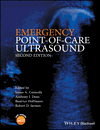The Use of Ultrasound in Evaluating Dyspnoea/Respiratory Distress in Infants and Children
Summary
Respiratory distress after birth may be due to several clinical conditions [e.g. transient tachypnea of the newborn (TTN), pneumothorax, pneumonia, sepsis, respiratory distress syndrome (RDS), congenital heart disease] that are often difficult to differentiate. At present lung ultrasound is not routinely included in the diagnostic work-up of respiratory distress of the newborn.
In pediatric age lung ultrasound has demonstrated to be useful in the diagnosis of pneumonia and bronchiolitis.
The normal lung picture in newborns and in pediatric age does not differ from that of the adult. Also the signs described for adults’ diseases are the same.
Ultrasound lung examination is performed through longitudinal and transversal sections of the anterior, lateral and posterior walls of the chest. A high-resolution linear probe 7.5-12 MHz must be used.



